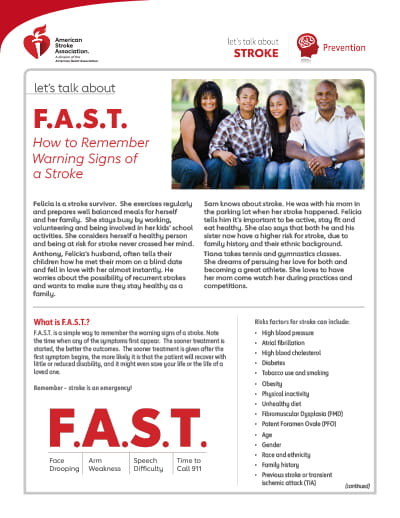Let’s Talk About F.A.S.T.

How to Remember Warning Signs of a Stroke
Felicia is a stroke survivor. She exercises regularly and prepares well balanced meals for herself and her family. She stays busy by working, volunteering and being involved in her kids’ school activities. She considers herself a healthy person and being at risk for stroke never crossed her mind.
Anthony, Felicia’s husband, often tells their children how he met their mom on a blind date and fell in love with her almost instantly. He worries about the possibility of recurrent strokes and wants to make sure they stay healthy as a family.
Sam knows about stroke. He was with his mom in the parking lot when her stroke happened. Felicia tells him it’s important to be active, stay fit and eat healthy. She also says that both he and his sister now have a higher risk for stroke, due to family history and their ethnic background.
Tiana takes tennis and gymnastics classes. She dreams of pursuing her love for both and becoming a great athlete. She loves to have her mom come watch her during practices and competitions.
What is F.A.S.T.?
F.A.S.T. is a simple way to remember the warning signs of a stroke. Note the time when any of the symptoms first appear. The sooner treatment is started, the better the outcomes. The sooner treatment is given after the first symptom begins, the more likely it is that the patient will recover with little or reduced disability, and it might even save your life or the life of a loved one.
Remember – stroke is an emergency!
Risks factors for stroke can include:
- High blood pressure
- Atrial fibrillation
- High blood cholesterol
- Diabetes
- Tobacco use and smoking
- Obesity
- Physical inactivity
- Unhealthy diet
- Fibromuscular Dysplasia (FMD)
- Patent Foramen Ovale (PFO)
- Age
- Gender
- Race and ethnicity
- Family history
- Previous stroke or transient ischemic attack (TIA)
What Felicia wants you to know about stroke
Anyone at any time can have a stroke. Each year nearly 800,000 people in the United States experience a stroke. Stroke is the 5th leading cause of death and a leading cause of long-term disability in the U.S.
It can happen to you. A stroke happens every 40 seconds, and approximately every four minutes someone dies from a stroke.
A stroke is a “brain attack.” It occurs when the flow of blood to the brain is blocked. When this happens, brain cells die and brain damage occurs.
Other signs of stroke include sudden:
- Weakness, numbness or paralysis of the face, arm or leg, usually on one side of the body
- Trouble speaking or difficulty understanding others
- Loss of vision in one or both eyes or double vision
- Loss of balance or coordination
- Severe headache with no known cause
How can I learn more?
- Call 1-888-4-stroke (1-888-478-7653) or visit stroke.org to learn more about stroke or find local support groups.
- Sign up for our monthly Stroke Connection e-news for stroke survivors and caregivers at StrokeConnection.org.
- Connect with others who have also had an experience with stroke by joining our Support Network at stroke.org/SupportNetwork.
Do you have questions for your doctor or nurse?
Take a few minutes to write down your questions for the next time you see your health care provider. For example:
What are my risk factors for stroke?
How can I reduce my risk for stroke?
We have many other fact sheets to help you make healthier choices to manage your condition or care for a loved one. Visit stroke.org/LetsTalkAboutStroke to learn more
© Copyright 2020 American Heart Association, Inc., a 501(c)(3) not-for-profit. All rights reserved. American Stroke Association is a registered trademark of the AHA. Unauthorized use prohibited.